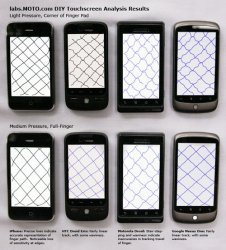http://labs.moto.com/diy-touchscreen-analysis/
Just read this from Electronista:
There are a number of painting programs on my iPhone, as well as any number of programs that rely on touch precision (Eliminator Pro for one). When the iPhone first came out in 2007, I'd picked up "Sketches" (I'd previously been a fan of the jailbroken version). Years later, I've happily purchased Brushes and Sketch Mobile and they've both been fantastic programs I look forward to using more.
Looking at these simple examples of poor-precision from these Android programs is the nightmare scenario I'd always been concerned about with the iPhone... that when it was finally tested, the iPhone's touchscreen would show that its version of "touch" sensitivity wouldn't be useable for painting programs. Instead, it sounds like the rush to release advanced hardware has made iPhone's competitors release products with the deficiencies I thought iPhone would have had (but never did).
~ CB
Just read this from Electronista:
http://www.electronista.com/articles/10/01/09/iphone.more.accurate.than.droid.nexus.one/MOTO Development Group in a study published Saturday has given the iPhone top marks for the quality of its touchscreen. Comparing it against multiple Android phones -- including the Nexus One, Droid and Droid Eris -- the hardware consultants found Apple's screen is the most accurate and lets users draw smooth, straight lines regardless of how quickly the finger moves or how much of it is in contact with the display. The Droid Eris and Nexus One were next with some erratic behavior with partial contact, while the Droid produced a similar effect no matter what contact has been made.
While all four phones have capacitive touchscreens, the iPhone's victory is credited to it having a small sensor size, a high sampling rate and intelligent-enough processing to determine where the finger is actually moving. The Droid by contrast may have a too-coarse sensor that can incorrectly guess the intended input and produce "stair steps."
Touchscreen performance hasn't been a major complaint for the Android phones in the test, but MOTO suggests that quality should be a greater focus and that companies making touch phones should devote more resources to them and take much of the hardware and software design in-house and as early as possible.
There are a number of painting programs on my iPhone, as well as any number of programs that rely on touch precision (Eliminator Pro for one). When the iPhone first came out in 2007, I'd picked up "Sketches" (I'd previously been a fan of the jailbroken version). Years later, I've happily purchased Brushes and Sketch Mobile and they've both been fantastic programs I look forward to using more.
Looking at these simple examples of poor-precision from these Android programs is the nightmare scenario I'd always been concerned about with the iPhone... that when it was finally tested, the iPhone's touchscreen would show that its version of "touch" sensitivity wouldn't be useable for painting programs. Instead, it sounds like the rush to release advanced hardware has made iPhone's competitors release products with the deficiencies I thought iPhone would have had (but never did).
~ CB


